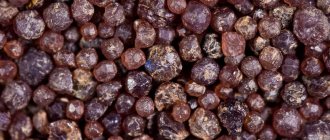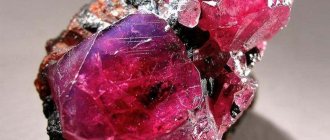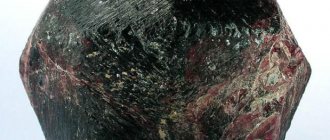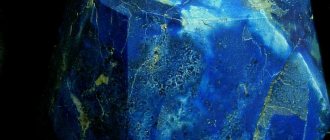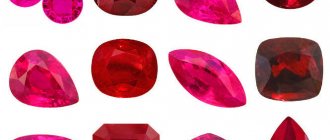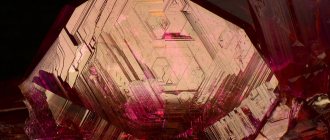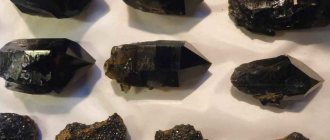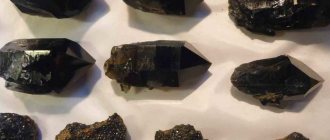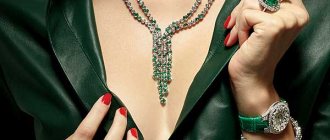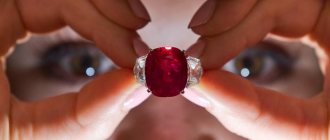| Property | Description |
| Formula | Al2O3 |
| Impurity | Cr |
| Hardness | 9 |
| Density | 3.99-4.10 g/cm³ |
| Refractive index | 1,763-1,772 |
| Kink | Conchoidal |
| singonia | Trigonal |
| Cleavage | Imperfect |
| Shine | Glass |
| Transparency | Transparent |
| Color | Red, red-brown, red-purple, red-pink. |
Colors and varieties
The main color of the mineral is blood red. The stone can also be fiery crimson, red-brown, yellowish-red, red-pink. The most valuable gem is one that has bluish or purple hues, the so-called “pigeon’s blood” colored stone.
Uncut ruby
Ruby is very close in composition to sapphire, which is also corundum (aluminum oxide), but does not have such a rich range of colors as its relative, therefore, if suddenly someone somewhere hears about a pink or green ruby, then most likely , we will talk specifically about sapphire. However, pink ruby still exists. This is a young natural gem of light pink or lilac shades.
Pink ruby ring
A star ruby is essentially a sapphire and can be any color. Its value lies in the shining six-rayed star located in the center of the processed stone.
Star ruby
A variety of ruby is anionite, a unique rock consisting of green cyosite with inclusions of dark pink or dark red ruby. The mineral is valued due to its amazing pattern, as well as the combination of colors created by the two rocks in this beautiful creation, the cost of which is very high.
Aniolite
The color and quality of a ruby depend on its deposit.
What were rubies called in Rus'?
In ancient times, the ancient Slavs also became acquainted with beautiful gems. Of course, only a few saw them, much less owned them. Today we know what precious corundums were called back then. They had the name yakhonty. It referred to rubies and sapphires.
According to linguists, the word “yakhont” originates from the Arabic word “Yakut”. This is what merchants from the Middle East called brightly colored gems. In ancient times, such a product was a real rarity that attracted rich people and rulers.
The Slavs called rubies red yakhont, sapphires were called azure yakhont. Rubies were endowed with special magical properties, the ability to heal not only the soul, but also the human body. Large red stones decorated the treasuries and crowns of the rulers of eastern countries.
Russian tsars also had a special love for rubies. Needless to say, more than 100 rubies were skillfully used to decorate the royal scepter. The Great Empress Catherine the Second received a wonderful gift during her reign. She was presented with a ruby the size of a pigeon's egg. This gift suited the great empress perfectly and was worthy of her beauty, power and wisdom.
During the Middle Ages, red yakhont was valued by kings and nobility even more than the most beautiful diamonds. In European countries, the deep red gem was commonly called carbuncle, burning coal or anthrax.
Place of Birth
Raw ruby crystal, length about 2 cm.
Apart from Antarctica, ruby is found on all continents.
The main ruby exporting countries are Myanmar, Thailand and Sri Lanka. Rubies from East Africa, from countries such as Kenya and Tanzania, are also in demand.
Since ancient times it has been mined in the Pamirs (Snezhnoye deposit in Tajikistan).
In Russia it does not form independent deposits, but is found only as a rare associated material in corundum deposits: the Southern Urals (Marble Log), Northern Karelia (Hit-Ostrov), the Kola Peninsula (Mount Peruselka), the Polar Urals (Rai-Iz).
Magical properties of ruby
Star Ruby Jewelry
This red gem is a stone of power. It has always been worn by people who have reached a high position, on whom the position of other people depends.
Esotericists have long believed that the magic of a ruby does not change a person. It only strengthens his character traits - both good and bad. Here the meaning of the stone is to be a catalyst for human qualities.
Therefore, a person with evil thoughts should not wear items made of red ruby. In this regard, the stone is “unprincipled”; it always indulges the passions of its owner. Whether it’s passionate love or the same passionate desire to ruin a rival by any means, to harm a rival... It’s better not to wish harm on your neighbors (and those far away too).
- Ruby is a stone of brilliance and vanity, pride and creative success.
- But these magical properties of the stone can energetically devastate the owner.
- Active, energetic people will find a harmonious ally in the gem.
- Ruby, its fiery color carries the symbolism of love, passion and fidelity.
- The magical properties of ruby protect the owner of the stone from evil forces and from astral attacks.
- If the color or shine of a gem has changed, this means you should be wary. These are signs of possible danger.
- Dedicated magicians love ruby - the stone gives them strength and power over the lower astral plane.
- Fire is the element of ruby. And the flames of passions are subject to the flame-colored stone.
- It is important to know that ruby is a symbol of love, but carnal love.
This is interesting!
Some esotericists believe that the property of ruby (lonely) is to attract loneliness. That is why it is recommended to wear rubies in pairs.
All properties apply only to real gems.
Astrological properties of rubies
The element of ruby is Fire. Now astrologers attribute the gem to the patrons of Leo and Aries. Their fiery, ardent nature will quickly find a “common language” with ruby. It is better to wear the stone in gold. Don’t rush to put on the purchased jewelry. Wait until the Sun moves into the constellation Aries or Leo. Then compatibility with the stone will be complete.
Jewelry with ruby
Ancient astrologers believed that the gem was suitable for Sagittarius according to their zodiac sign.
Signs not suitable for ruby according to the horoscope:
- Virgo;
- Calf;
- Cancer.
The patron planets of the stone are the Sun, Mars.
Medicinal properties
Uncut ruby
Lithotherapists of our time have described the following healing capabilities of ruby:
- improving the functioning of the immune system;
- wound healing;
- improving blood flow, heart function, improving blood pressure, toning blood vessels;
- improvement of brain functions;
- sedative for stress or depression;
- assistance in the treatment of paralysis, epilepsy, schizophrenia;
- treatment of joint diseases;
- elimination of problems of the digestive system, in particular, treatment of stomach ulcers.
Ruby is considered a hemostatic agent. It also has an antipyretic effect, relieves bad dreams, cures chronic tonsillitis, diseases of the kidneys, liver and spine.
Did you know that medieval Aesculapians used ruby to treat the plague?
A sunbeam passed through a ruby is endowed with healing powers. Healers claim that such light has a positive effect on metabolism, restores tissue, and has an anti-inflammatory effect.
Important!
People suffering from hypertension (high blood pressure) or blood incoagulability (hemophilia) are contraindicated from wearing a ruby!
Ruby-charged water is an effective way to maintain beauty and health. To do this, leave the gem in water overnight, and then drink the liquid or wash it with it. This technique helps to quickly recover from stress, restore strength after illness, or simply maintain natural beauty.
Ruby stone - healing properties
In ancient India, the mineral was used in the treatment of epilepsy, paralysis and depression. In Europe in the Middle Ages, a powder was made from it, which was “prescribed” to rich patients to treat the gastrointestinal tract (the powder should be drunk by dissolving the powder in wine), as well as impotence. In modern lithotherapy, the mineral plays a large role in the treatment of diseases such as hypertension, bronchial asthma, diseases of the eyes, throat, ears, joints and spine. Helps get rid of insomnia and depression.
Healing properties are not only manifested when wearing jewelry with a gem, but also when drinking a water infusion (the larger the size of the stone, the more healing the infusion - ancient healers believed). Needless to say, synthetic ruby cannot have healing properties.
Talismans and amulets
Faceted ruby
The stone is an excellent amulet and amulet for military personnel and firefighters, protecting them from death. It warns owners of danger by changing its color.
It is believed that the ruby talisman will protect against natural disasters and negative magical effects. If you have a ruby crystal in your house, it will protect your home from fire and thieves.
If you wear a stone amulet constantly, then good luck will always accompany its owner. Any situation, be it finances, health or work, will change for the better. The energy of the stone allows a person to strive for everything new and unknown, opening up vast horizons of possibilities. Such a talisman will help people of mental and creative professions, as well as those who love adventure.
A gem amulet can bring prophetic dreams. If a person dreams of a ruby, then good luck, success and prosperity await him in life.
Areas of application of ruby
- Synthetic ruby was used as the light-emitting active medium in the first laser, created in 1960 by Theodore Maiman. Synthetic ruby lasers continue to be produced and used to this day.
- A category I gemstone, used in expensive jewelry.
- Synthetic corundums called “rubies” are used in the jewelry industry for inserts in inexpensive products and as “stones” in watch movements.
History and description of the stone
The properties of ruby have made it extremely popular since its discovery. The stone is believed to have been discovered in the Bronze Age. Along with other precious minerals, it became a symbol of the nobility, and was also often used for rituals. This material was used to create the following products:
- amulets;
- amulets;
- jewelry (any kind, the most common were earrings, rings and necklaces);
- dishes (most often cups);
- figurines.
The gem is sometimes called “yakhont” or “sardis”. However, these names are outdated. In addition, the mineral had a whole list of more ancient names, which were most often associated with legends about the origin of ruby. It was often called “corundum”, but this name is also inaccurate. The stone is actually just a type of corundum.
Ruby products and jewelry
Ruby ring
Ruby is widely used in jewelry. Absolutely all jewelry can be decorated with it: rings, earrings, bracelets, rings, necklaces, necklaces, etc.
Every girl or woman will be pleased with exquisite ruby jewelry, of which there is such a variety that you can satisfy even the most demanding taste.
A ruby in silver looks most luxurious. This noble metal allows the mysterious and bewitching stone to fully reveal itself.
The silver ring with a ruby is especially chic. If it is intended for everyday wear, then it is better to choose a thin ring that will look stylish and modest, and for going out in public, massive rings with large rubies of dark and rich colors of an exclusive cut are suitable.
Ruby in silver fits perfectly into any style and image, and is suitable for both stylish and business women, as well as sensual beauties. Absolutely everyone - both blondes and brunettes - will be able to choose a piece of jewelry to their liking.
For an engagement, you should choose a gold ring with a ruby, as it is a symbol of fiery love and devotion. Such a ring will support the fire of feelings and will not allow love and passion to go out for a long time.
Black Prince's Ruby
"Edward's Ruby" or "Black Prince's Ruby", weighing 167 carats, which is now on display at the British Natural History Museum in London.
Its history begins in the middle of the 14th century. At first it belonged to Abu Said, the Moorish prince of Granada. But in those days, the reconquista began - the process of the conquest of Muslim states by Christian kingdoms, which are located on the Iberian Peninsula.
Don Pedro the Cruel, ruler of Castile, opposed Abu Said. He captured most of Granada, and then, Abu Said came to Seville to surrender to Pedro. But Don Pedro's servants killed the Moorish prince, and, after searching his body, they found a large ruby, the size of an egg. But the stone did not bring good luck to the ruler of Castile.
In 1366, his half-brother rebelled against him, wanting to seize power into his own hands. Don Pedro has to look for support on the side, since his own troops were clearly not enough for him to defeat the enemy. He enters into an alliance with Edward of Wales, nicknamed "The Black Prince". With the help of his allies, Pedro the Cruel suppresses the uprising and pays for it with Abu Said's ruby. Thus, the stone comes to England and is given a name after its owner - “Edward’s Ruby” or “Black Prince’s Ruby”.
Then the stone is inherited by King Henry V. Of all his precious stones, Henry singled out this particular ruby, believing that it symbolizes the desire for victory and is capable of helping in achieving the chosen goal. It was no coincidence that he thought so. Shortly before the Battle of Agincourt, this particular stone was inserted into the king's combat helmet.
During the battle, Henry V received a powerful blow with a heavy sword directly on the helmet, where a ruby adorned itself in the very center. But, surprisingly, both the ruby itself and its owner survived. And, even, the battle was completely won.
A later owner of the Black Prince's Ruby, Richard III, who also wore it at the Battle of Bosworth Field in 1485, died.
Already in the 16th century, King James I of England ordered the “Ruby of the Black Prince” to be inserted into the royal crown, in which it remained until the time of the English bourgeois revolution of the 17th century, until Oliver Cromwell, the leader of this revolution, ordered the dismantling of all precious stones from the royal regalia. The Black Prince's Ruby was sold to a simple London jeweler. When the monarchy was restored in England in 1660, the jeweler sold the stone back to Charles II.
Much later, in the 19th century, they were able to determine that this stone was not a ruby at all, but a spinel*. But, until this time, all red gemstones were considered “rubies.” Spinel can be distinguished from ruby only by its lower hardness and density.
This is where the turbulent history of this famous ruby ends. Now it can be seen in the natural history museum in the very center of the imperial crown of the main monarch of the country.
Monomakh's hat
The famous Monomakh's Cap, presented to Tsar Ivan the Terrible, contained a noble spinel instead of four rubies. The large imperial crown is also crowned with a spinel measuring 398.72 carats.
Ruby in books
In A. Kuprin’s story “Sulamith,” King Solomon says: “Anthrax, the sacred stone of the land of Ophir. It's hot and humid. Look, it is red, like blood, like the evening dawn, like a blossoming pomegranate, like thick wine from the vineyards of Enged... This is a stone of love, anger and blood. On the hand of a person languishing in a fever or intoxicated with desire, it becomes darker and burns with a red flame... If it is crushed into powder and taken with water, it gives a glow to the face, calms the stomach and cheers the soul. The one who wears it gains power over people. He heals the heart, brain and memory.”
Russian medical books said : “Whoever carries a yacht with him will not see terrible and dashing dreams... If someone, looking at the sun, darkens his eyes, then it will help him if he rubs it with that stone... And if you rub it on the head, on the hair with that stone, then the flesh of the head is drawn within itself, like an iron magnet... If someone wears a yacht in a ring with him, he will strengthen his heart and be honest with people.”
Portraits of the nobility with rubies
Alessandro Allori. Marie de Medici, Wife of Henri IV of France.
Ivan Makarov. Grand Duchess Maria Alexandrovna.
Jean Auguste Dominique Ingres. Portrait of the Baronness James de Rothschild. 1848
Jean Auguste Dominique Ingres. Portrait of the Madame Moitessier. Flora (Lucrezia Borgia?). Portrait by Bartolomeo Veneto.
How much can a ruby cost?
Gold earrings with rubies
The value of a ruby is determined by the following parameters:
- color of the stone - the richer and brighter, the better;
- structure - cracks, darkening or bubbles reduce the price;
- weight - a carat of a large specimen is more expensive than a carat of a small one;
- cut - if the lower segment is larger than the upper, the stone is more expensive;
- inclusions reduce the price, but a uniform soft “silk” in a transparent crystal (no frills) is welcome.
Rubies, as high-class stones, are sold at auctions.
A certificate for a ruby purchased at a salon must indicate whether the stone has been refined or is 100% natural. Most salons or online stores sell synthetic or heated rubies.
Natural stone of rich, bright color is very rare in nature. The cost of the most valuable pigeon's blood ruby is from $50,000 per carat.
Cost table:
| Stone quality, carat weight | How much is a carat of ruby worth in US dollars? |
| Commercial quality, per 1 carat | 600-6 000 |
| Premium quality, 1-2 carat stones | 1500-17 000 |
| Premium quality, stones 4-5 carats | 6 000-32 000 |
| Top quality, 1-2 carat stones | 12 000-25 000 |
| Top quality, weighing 4-5 carats | 40 000-60 000 |
Most jewelry stores offer items made of silver or gold of the lowest standard with heated rubies or even artificial ones, which a person with average income can afford. Prices for such jewelry are several times lower than the cost of elite products:
- A budget ring made of sterling silver or 14k gold with an artificial stone starts at $200. A natural heated ruby will cost several times more;
- earrings of similar quality cost from $300;
- pendants will cost an average of $300-500;
- the bracelet costs from $900.
Red ruby: name and history
The name comes from the Latin word “rubeus” - “red”. The ancient name of ruby is noble red corundum, lala, manikiya, ratnanayana. It is believed that the stone became known in Europe in the 4th century. BC, when the campaigns of Alexander the Great took place. Meanwhile, it is likely that under the guise of carbuncles the stone was known even in earlier times, brought from Africa. The gem was highly valued in the East and India. Of course, only the highest nobility could afford jewelry with rubies. Since then it has been considered a “royal” stone. In India and Burma, it has been considered a talisman and amulet since ancient times.
Burmese is the most expensive ruby in the world
How much is a ruby worth? The most expensive is the Sunrise ruby, which was sold in 2015 at Sotheby’s for $30.3 million. It was found in Burma, weighs 25.59 carats and is pigeon's blood in color.
Yakhont worm-shaped is the ancient name for ruby in Rus' (and Yakhont azure is a sapphire).
Artificial ruby
Synthetic pink rubies
Natural stone is available only to a few, so technologies for producing an analogue have been developed. This is the first gem reproduced by people.
Ruby crystals are grown in several ways. The most popular is the Verneuil method. The Frenchman obtained “Siamese rubies” by fusing ruby powder. In three hours, a 30-carat synthetic stone is obtained. It looks natural.
In the 20th century, new methods for producing artificial crystals appeared:
- Czochralski and zone melting methods, crystallization from solutions in the melt or from the gas phase;
- hydrothermal method.
Latest most popular:
- cheap minerals are mixed with additives and melted;
- the mass is crystallized under a set pressure and at high temperature;
- Large stones are formed; their composition and properties are identical to natural ones.
Such rubies are called hydrothermal.
All rubies in Soviet jewelry from jewelry stores are artificial.
How to spot a fake
Even centuries-old jewelry can be set with an artificial ruby. Most Soviet jewelry sparkles with synthetic rubies.
It is not easy to distinguish a natural ruby from an artificial one. Without special equipment and analysis, the stone can easily be confused with spinel.
The best advice for anyone who wants to determine the authenticity of a stone in jewelry is to seek the help of a gemologist or jeweler.
You should buy expensive jewelry with rubies in salons where you will be provided with a certificate. It verifies that the stone is natural and provides the size, cut and data of the gem.
It is difficult to determine the authenticity of a stone without specialists. Try:
- Dab your fingernail or coin firmly across the surface. A cheap fake will have a scratch. A natural ruby can only be scratched with a diamond.
- Scratch the ruby onto glass or ceramic. A red scratch remained - in the hands of a mineral softer than ruby. Or refined stone.
- Under ultraviolet light, a natural gem will glow like a coal. Synthetic will give an orange-crimson glow.
- In daylight, sunlight, natural stone will look deep pink. Indoors, under artificial lighting, the color will change to darker.
- Natural ruby is reluctant to “share its warmth.” Hold your finger (or apply it to your eyelid, to the tip of your nose) the stone. If it heats up quickly, it's a cheap fake. Remains cold for a long time - there is a high probability that the stone is natural.
But only a real gemologist can distinguish a fake and give a guarantee (with a piece of paper and a seal). He will check (instrumentally) the authenticity of the ruby.
How to distinguish an original from a fake
ring
is very expensive, so fakes often appear on the market. To check the authenticity of a gem at home or when purchasing, you can see what a ruby looks like under a magnifying glass.
Nature is a strict mother, so genuine stones formed in the bowels of the earth are very rarely perfect; you can see small air bubbles, foreign inclusions, cracks, and abrasions in them. There are other ways to expose scammers.
- In the old days, the authenticity of red corundum was checked by placing it in a container of milk. If the crystal is real, it turns pinkish.
- It is very difficult to imitate the play of light. Natural crystal will refract the sun's rays. If you look at it from different angles, the shade will change slightly.
- The crudest fakes made of glass or plastic can be identified by clenching them in your fist. The genuine gem will remain cold, the glass will heat up. But an artificial stone grown in a laboratory will pass such a test.
- If you put the crystal in a glass, it will glow pink. When ultraviolet rays are shined on it, the stone turns orange.
When purchasing, it is important to remember that only genuine minerals have magical and healing properties. A synthetic ruby grown in a laboratory is useless as a talisman. A piece of plastic or glass - even more so.
Crystal Care
For all its hardness, ruby is a fragile stone. It is necessary to protect ruby products from falling or hitting hard surfaces.
But ruby is able to scratch other gems - its hardness is second only to that of diamond. Therefore, a separate house - a case or bag made of dense soft fabric - is suitable for decoration. Rubies do not like to be exposed to the hot sun for long periods of time, so store them in the dark and avoid wearing jewelry with these stones in hot countries.
Cleaning at home is simple:
- If your jewelry is dirty, dilute baby soap in warm water and carefully rinse the stone in this solution. Use a used (not hard) toothbrush or just a napkin. Rinse the jewelry and wipe gently with a dry cloth.
- If you are going to work with your hands, remove the ruby ring. Household chemicals are not at all beneficial for gems.
- It is better to take heavily soiled jewelry to a jeweler, he will clean it using special methods and means.
We recommend: Sunstone YELLOW TOPAZ
Interesting: choose a place to store ruby jewelry in the southern part of the house. According to Feng Shui, this will increase the social status of the family in general and the owner in particular.
Who suits the name
Jewelry with ruby
Ruby favors those who are called by the following names:
- Allah. The stone will awaken pure thoughts in her, but will also bring trials into her life to achieve them.
- Benjamin. Ruby will help him improve leadership skills, determination, and a sense of responsibility, eliminating uncertainty and sad thoughts.
- Varvara. For such a girl, the gem will become a love talisman, bringing happiness in matters of the heart.
- Pavel will be able to overcome his complexes, gain leadership qualities, and become responsible with a ruby amulet.
- Faith will gain strength and confidence to achieve your goals. Ruby will help this girl gain recognition, fame, and will also protect family happiness, protect her from troubles and troubles.
- Victor will strengthen his characteristic sense of purpose, dignity and courage. And also the ruby will relieve him of fears and worries.
It must be remembered that ruby helps only those who know what they want to achieve. When the owner goes to the goal according to the principle “all means are good”, the stone will “teach” such a person a lesson, contributing to the loss of everything accumulated. This is worth considering when choosing a talisman.
